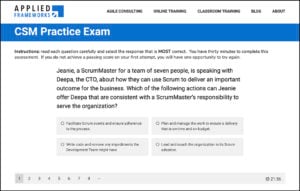Practice Scrum Master Exam Question
In early 2020, we created a Certified ScrumMaster (CSM) practice exam to help our learners prepare themselves for the official CSM exam administered by the Scrum Alliance. Like the Scrum Alliance exam, our practice ScrumMaster exam questions are divided into seven broad areas, ranging from Scrum theory to the various artifacts found in Scrum, designed to evaluate a test taker’s understanding of core concepts of the Scrum Guide, the official definition of Scrum. Unlike the Scrum Alliance exam, our practice exam is widely available to anyone on the Internet.
Since we launched the practice exam, we’ve been amazed by the response: thousands of people have completed the test, which typically takes less than 30 minutes. In a post-test survey, 47 percent of respondents told us that they took the practice test during or after their Certified Scrum Master class. So it’s fair to say that many of the test takers had a fair bit of expertise in the subject matter, while many were novices with only a basic understanding of Scrum concepts.
With thousands of practice exams recorded, we’ve assembled a data set that yields some insight into which Scrum Master exam questions are most likely to trip you up — regardless of your level of expertise.
The Trickiest Scrum Master Exam Questions
My take on the data is that current and potential ScrumMasters experience confusion and doubt about their role and the Scrum framework. The most common misunderstandings include:
- According to the Scrum Guide, ScrumMasters have a responsibility to ensure the healthy use and adoption of Scrum in the organization. “They do this by helping everyone understand Scrum theory and practice, both within the Scrum Team and the organization.” However, nearly 33 percent of our test takers were unable to identify how the ScrumMaster helps Product Owners, or senior leaders, be more effective with Scrum.
- Another area where ScrumMasters have doubts is in the area of Scrum events and artifacts. Nearly 40 percent of test takers could not correctly identify the purpose of the Daily Scrum, the parts of Sprint Planning or the characteristics of a Sprint Backlog. This is problematic because if the people responsible for the healthy use and adoption of Scrum cannot describe what good Scrum looks like, then the organization is not going to reap the benefits of adopting Scrum and Agile.
- Forty-five percent of the people taking the practice exam confused user stories with Product Backlog items. This is not entirely surprising since user stories have become the default pattern for documenting Product Backlog items (PBI). However, there are a lot of bad habits people have adopted with respect to user stories. These bad habits overemphasize the completion of “tickets” and de-prioritize the delivery of value, aka the build trap.
- About 40 percent of test takers could not identify that during a Sprint “quality does not decrease.” In Scrum, the quality standard to which PBI, and the Developers, are evaluated against is called the Definition of Done (DoD). In order for the product Increment to be considered usable, quality must be kept high. Maintaining the product increment in a usable state is so important to empiricism that the Scrum Guide states that PBI which do not meet the DoD “cannot be released or even presented at the Sprint Review.”
- About 25 percent of people taking the practice exam believe that good Scrum practice entails having days between Sprints for bug fixing, system testing, refactoring, test automation and/or documentation. Let me be 100% clear: there are no pauses or gaps between Sprints. Sprints are scheduled one after another. There is no period in Scrum specifically for bug fixing, system testing, refactoring, test automation and/or documentation since those activities would be completed by the Developers during a Sprint in accordance with their Definition of Done (DoD).
Practice Exam Performance Trends
60 percent of test takers pass our exam on the first try. However, the average score of all people who take the our test (passers and non-passers) is 71 percent. 71 percent is four points shy of the 75 percent needed to pass the official Scrum Alliance exam. This leads me to conclude that general knowledge about Scrum is insufficient to pass the official CSM exam.
If we look at the performance of students attending an Applied Frameworks’ CSM course, their average score on the official exam is 87 percent! I feel this difference — nearly sixteen percentage points — is notable and results from attending our Certified ScrumMaster course, which is specially designed for retention by adult learners.





